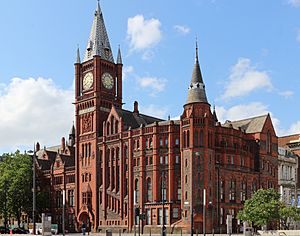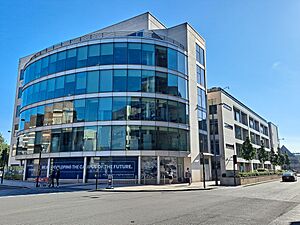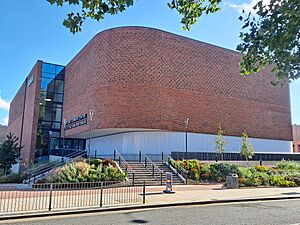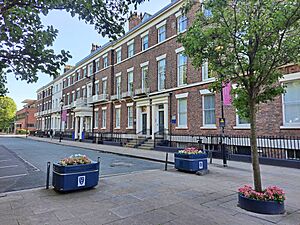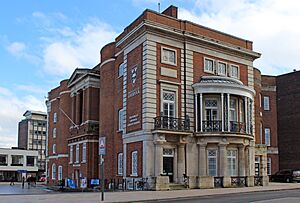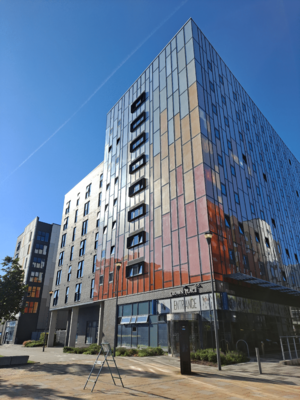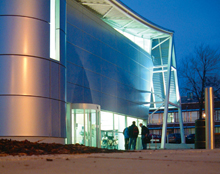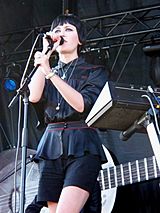University of Liverpool facts for kids
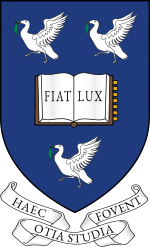
Coat of arms
|
|||||||||||||||||||||
| Latin: Universitas Lyrpulensis | |||||||||||||||||||||
| Motto | Latin: Haec otia studia fovent | ||||||||||||||||||||
|---|---|---|---|---|---|---|---|---|---|---|---|---|---|---|---|---|---|---|---|---|---|
|
Motto in English
|
These days of peace foster learning | ||||||||||||||||||||
| Type | Public | ||||||||||||||||||||
| Established | 1881 – University College Liverpool 1884 – affiliated to the federal Victoria University 1903 – royal charter |
||||||||||||||||||||
| Endowment | £193.8 million (2024) | ||||||||||||||||||||
| Budget | £705.3 million (2023/24) | ||||||||||||||||||||
| Chancellor | Wendy Beetlestone | ||||||||||||||||||||
| Vice-Chancellor | Tim Jones | ||||||||||||||||||||
| Visitor | The Lord President of the Council ex officio | ||||||||||||||||||||
|
Academic staff
|
3,325 (2023/24) | ||||||||||||||||||||
|
Administrative staff
|
4,015 (2023/24) | ||||||||||||||||||||
| Students | (2015/16) 27,820 FTE (2015/16) |
||||||||||||||||||||
| Undergraduates | (2015/16) | ||||||||||||||||||||
| Postgraduates | (2015/16) | ||||||||||||||||||||
| Location | , | ||||||||||||||||||||
| Campus | Urban | ||||||||||||||||||||
| Colours | The University |
||||||||||||||||||||
| Affiliations |
|
||||||||||||||||||||
 |
|||||||||||||||||||||
The University of Liverpool (often called UOL) is a big public university in Liverpool, England. It's a place where students go to learn and do important research.
The university started in 1881 as University College Liverpool. In 1903, it got a special permission from King Edward VII to give out its own degrees. This meant it became a fully independent university.
The University of Liverpool owns and looks after some amazing historic places. These include the Liverpool Royal Infirmary, the beautiful Ness Botanic Gardens, and the Victoria Gallery & Museum.
The university has three main sections, called faculties, which are split into 35 schools and departments. They offer over 230 different courses for first-degree students in 103 subjects. It's also a founding member of the Russell Group, which is a group of top research universities in the UK. It's also part of the N8 Group, a research group in Northern England.
The famous phrase "redbrick university" was inspired by the university's own Victoria Building. This building is made of red brick, and the university proudly says it's the original "redbrick university."
Liverpool was the first university in the UK to create departments for studying the ocean (oceanography), city planning (civic design), building design (architecture), and how living things work at a tiny level (biochemistry). It was also the first UK university to open its own campus in China, called Xi'an Jiaotong-Liverpool University. The university also started the University of Liverpool Mathematics School, a special school for advanced maths.
Many famous people have studied or worked at the University of Liverpool. Ten Nobel Prize winners have been connected to the university. These include people who made big discoveries in medicine, law, business, and science.
Contents
History of the University
How the University Started
The University of Liverpool began in 1881 as College Liverpool. Its first students started in 1882. A few years later, in 1884, it joined a larger group of universities called the Victoria University.
In 1894, a professor named Oliver Lodge made history at the university. He sent the world's first public radio transmission. Just two years later, the first surgical X-ray in the United Kingdom was taken there. The university also started its own publishing company, the Liverpool University Press, in 1899. This makes it the third-oldest university publisher in England.
Becoming an Independent University
In 1903, the university received a special permission from the King. This allowed it to become an independent university and give out its own degrees. This was a big step!
The years that followed brought many important discoveries. Sir Charles Sherrington discovered how brain cells communicate, called the synapse. William Blair-Bell worked on chemotherapy to treat cancer. Later, in the 1930s and 1940s, Sir James Chadwick and Sir Joseph Rotblat helped develop the atomic bomb. From 1943 to 1966, Professor Allan Downie played a key role in getting rid of smallpox disease.
In 1994, the university became a founding member of the Russell Group. This group includes 20 top universities known for their strong research. In the 21st century, scientists and engineers from the university helped build the Large Hadron Collider at CERN. This is a huge machine used to study tiny particles.
Since 2019, the university has partnered with Kaplan Open Learning to offer its online courses.
Nobel Prize Winners from Liverpool
The University of Liverpool is proud to have had ten Nobel Prize winners connected to it. These are people who made huge discoveries that changed the world.
- Sir Ronald Ross (1902, Medicine): For his work on malaria.
- Charles Barkla (1917, Physics): For discovering properties of X-rays.
- Sir Charles Sherrington (1932, Physiology/Medicine): For his research on neurons (nerve cells).
- Sir James Chadwick (1935, Physics): For discovering neutrons, tiny parts of atoms.
- Sir Robert Robinson (1947, Chemistry): For his research on natural chemicals.
- Har Gobind Khorana (1968, Physiology/Medicine): For his work on how our bodies make proteins.
- Rodney Porter (1972, Physiology/Medicine): For discovering the structure of antibodies, which fight off diseases.
- Ronald Coase (1991, Economics): For his ideas on how businesses work.
- Joseph Rotblat (1995, Peace): For his efforts to stop nuclear weapons.
- Martin Lewis Perl (1995, Physics): For discovering a new type of particle called the tau lepton.
Campus and Facilities
The university's main campus is in the city of Liverpool, just a short walk from the city centre. It covers 100 acres and has 192 buildings. These buildings include 69 lecture halls and many teaching and research areas.
The main campus has three faculties: Health and Life Sciences, Humanities and Social Sciences, and Science and Engineering. The Veterinary Teaching Hospital and Ness Botanical Gardens are located outside the main campus, on the Wirral Peninsula.
The university has 51 buildings for students to live in, offering 3,385 rooms. Students can choose between catered (meals provided) or self-catering options. The most famous building on campus is the original red brick Victoria Building. It opened in 1892 and was restored in 2008. It now houses the Victoria Gallery and Museum, which is open to the public.
The university has invested a lot of money to improve student life. This includes building new student housing and updating facilities. For example, new Central Teaching Laboratories for science subjects opened in 2012.
In 2013, the University of Liverpool also opened a smaller campus in London. This campus offers special master's degree programs for professionals.
Central Teaching Hub
The Central Teaching Hub is a large, modern building on campus. It has updated lecture halls and teaching labs for Chemistry, Physics, and Environmental Sciences. It opened in 2012 and cost about £23 million.
The main part, the 'Central Teaching Laboratory', has a big open space inside. It contains seven labs that can hold 1,600 students at once. There are also flexible teaching areas, computer centres, and study spaces.
Being a Green University
The University of Liverpool cares about the environment. In 2008, it was ranked as one of the greenest universities in Britain by the Green League, supported by WWF. This was a big improvement from previous years.
The university earned high marks for its environmental policies, waste management, and ethical investments. It also scored well for reducing carbon emissions and saving water and energy.
Liverpool was the first UK university to create its own system for saving power on desktop computers. This system has been used by many other universities. The university also uses special software to save energy when computers are doing complex tasks.
In 2024, the Interdisciplinary Centre for Sustainability Research (ICSR) was created. This centre works to help achieve the United Nations Sustainable Development Goals, which are goals for a better and more sustainable future for everyone.
How the University is Organized
The University of Liverpool is a research-focused university. It has 33,000 students studying over 450 different programs in 54 subject areas. It offers a wide range of courses in both arts and sciences. The University of Liverpool School of Medicine, started in 1835, is one of the largest medical schools in the UK. It works closely with the nearby Royal Liverpool University Hospital.
The university has a students' union called the Liverpool Guild of Students. This group helps represent students' interests and provides support.
University Leaders
The main leader of the university is the Chancellor. The current Chancellor is Wendy Beetlestone.
The person who runs the university day-to-day is the vice-chancellor. The current Vice-Chancellor is Tim Jones.
University Faculties
Since 2009, the university's teaching departments have been grouped into three main faculties:
|
Faculty of Health & Life Sciences
|
Faculty of Humanities & Social Sciences
|
Faculty of Science & Engineering
|
Student Life
University Accommodation
The university offers many places for students to live, both on campus and in student villages nearby. As part of a big investment to improve student life, the university has built new halls and updated existing ones.
Here are some of the places students can live for the 2025/2026 school year:
- On-campus
- Crown Place
- Philharmonic Court
- Vine Court
- Dover Court
- Tudor Close
- Melville Grove
- Off-campus
Greenbank Student Village
- Derby
- Roscoe
- Derby Old Court
In 2021, "Gladstone Halls" was renamed after Dorothy Kuya, a leading communist and anti-racist leader.
Sports at the University
The University of Liverpool has a strong tradition in sports. Its sports program, called Sport Liverpool, offers over 50 different sports. These include popular sports like football, rugby, cricket, and hockey, as well as others like windsurfing, lacrosse, and cheerleading.
Many sports have both male and female teams. Most teams compete at a national level through BUCS, which organizes competitions for universities across the UK.
Two other important competitions are the Christie Championships and the Varsity Cup. The Christie Cup is a competition between Liverpool, Leeds, and Manchester universities. The Varsity Cup is a popular local competition between the University of Liverpool and Liverpool John Moores University.
Famous People Who Studied Here
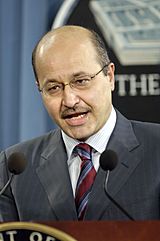
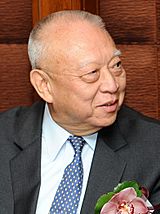
Many notable people have studied at the University of Liverpool. Here are just a few:
- Clive Barker, writer and film director
- Wade Barrett, professional wrestler
- Roger Bolton, TV producer
- Carol Ann Duffy, Poet Laureate
- Nick Grimshaw, radio and TV presenter
- Rose Heilbron, first female judge in England
- Beverley Hughes, former Member of Parliament
- Sir Dawda Kairaba Jawara, first President of The Gambia
- Sanjay Jha, former CEO of Motorola's Mobile Devices
- Sir Ian Kershaw, famous historian
- Chris Lowe, musician (from Pet Shop Boys)
- Helen Marnie, musician (from Ladytron)
- Anna Maxwell Martin, actress
- Michael Rosen, children's writer
- Patricia Routledge, actress
- Barham Ahmad Salih, former President of Iraq
- Dame Stella Rimington, former head of MI5 (UK's security service)
- Jon Snow, TV news presenter
- Edward Snowden, former system administrator
- Olaf Stapledon, novelist and philosopher
- Tung Chee-hwa, first Chief Executive of Hong Kong
- Sid Watkins, former Formula 1 chief medical officer
Images for kids
-
Charles Scott Sherrington, Nobel Prize winner.
-
Charles Glover Barkla, Nobel Prize winner.
See also
 In Spanish: Universidad de Liverpool para niños
In Spanish: Universidad de Liverpool para niños


